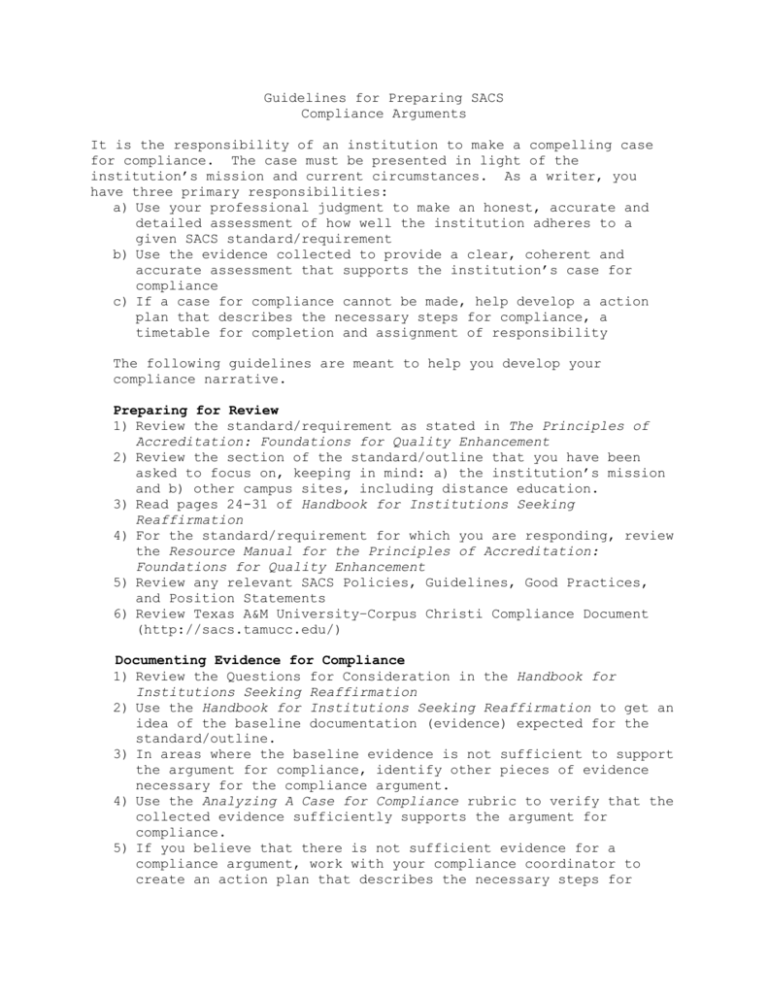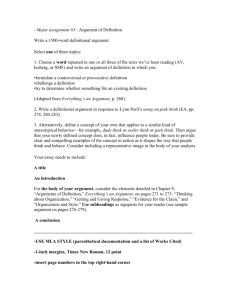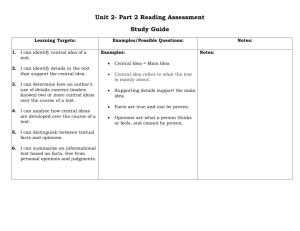Guidelines for Preparing SACS Compliance Arguments It is the
advertisement

Guidelines for Preparing SACS Compliance Arguments It is the responsibility of an institution to make a compelling case for compliance. The case must be presented in light of the institution’s mission and current circumstances. As a writer, you have three primary responsibilities: a) Use your professional judgment to make an honest, accurate and detailed assessment of how well the institution adheres to a given SACS standard/requirement b) Use the evidence collected to provide a clear, coherent and accurate assessment that supports the institution’s case for compliance c) If a case for compliance cannot be made, help develop a action plan that describes the necessary steps for compliance, a timetable for completion and assignment of responsibility The following guidelines are meant to help you develop your compliance narrative. Preparing for Review 1) Review the standard/requirement as stated in The Principles of Accreditation: Foundations for Quality Enhancement 2) Review the section of the standard/outline that you have been asked to focus on, keeping in mind: a) the institution’s mission and b) other campus sites, including distance education. 3) Read pages 24-31 of Handbook for Institutions Seeking Reaffirmation 4) For the standard/requirement for which you are responding, review the Resource Manual for the Principles of Accreditation: Foundations for Quality Enhancement 5) Review any relevant SACS Policies, Guidelines, Good Practices, and Position Statements 6) Review Texas A&M University–Corpus Christi Compliance Document (http://sacs.tamucc.edu/) Documenting Evidence for Compliance 1) Review the Questions for Consideration in the Handbook for Institutions Seeking Reaffirmation 2) Use the Handbook for Institutions Seeking Reaffirmation to get an idea of the baseline documentation (evidence) expected for the standard/outline. 3) In areas where the baseline evidence is not sufficient to support the argument for compliance, identify other pieces of evidence necessary for the compliance argument. 4) Use the Analyzing A Case for Compliance rubric to verify that the collected evidence sufficiently supports the argument for compliance. 5) If you believe that there is not sufficient evidence for a compliance argument, work with your compliance coordinator to create an action plan that describes the necessary steps for compliance, a timetable for completion, and assignment of responsibility. Developing a Rational for Compliance 6) Using collected documentation, create a clear, succinct, and convincing written argument for compliance. 7) Verify that each assertion made in the argument has evidence and that the documentation is explained in the argument. 8) Use the Analyzing A Case for Compliance rubric to verify that the written argument sufficiently supports the argument for compliance. Finalizing Draft Document 9) Place the written argument in the word template provided. 10) In the Evidence section of the document, list the pieces of evidence in the order in which it appears in the document. 11) Using the numbers provided for the evidence in the Evidence section of the document, indicate in the written argument where in the document that each piece of evidence should be located. 12) Provide all evidence in PDF format. 13) Name all the evidence according to the following naming conventions: Evidence Document filename convention: type-#-fullname Type: BD-Board Document, UD-University Document, SD-State Document Numbering: Use three digits and number sequentially Example: BD-001-TAMUS Policies and Regulations Web site BD-002-TAMUS 01-04 Items Requiring Action by the Board of Regents







